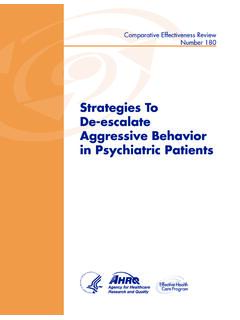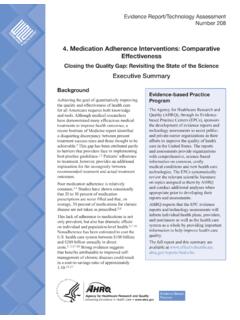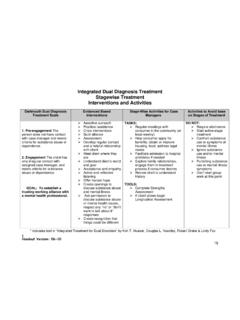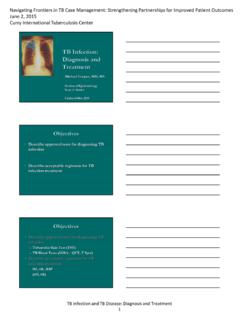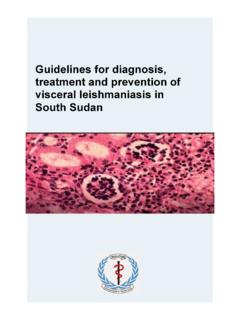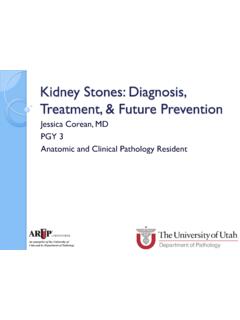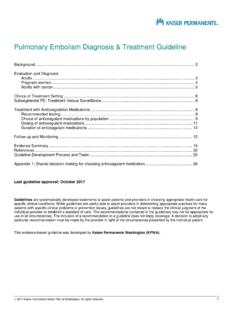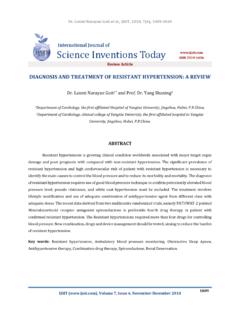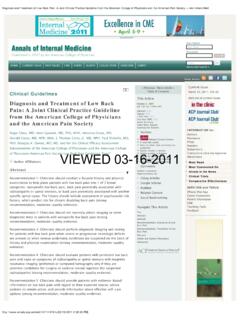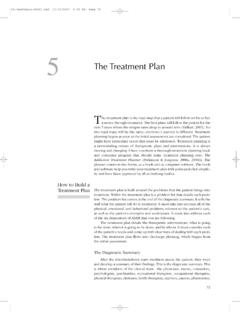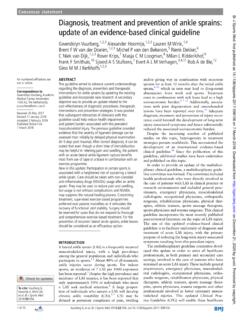Transcription of Attention Deficit Hyperactivity Disorder: Diagnosis and ...
1 Comparative Effectiveness Review Number 203 Attention Deficit Hyperactivity Disorder: Diagnosis and treatment in Children and AdolescentseComparative Effectiveness Review Number 203 Attention Deficit Hyperactivity Disorder: Diagnosis and treatment in Children and Adolescents Prepared for: Agency for Healthcare Research and Quality Department of Health and Human Services 5600 Fishers Lane Rockville, MD 20857 Contract No. 290-2015-00004-I Prepared by: Duke Evidence-based Practice Center Durham, NC Investigators: Alex R. Kemper, , , Gary R. Maslow, , Sherika Hill, , Behrouz Namdari, Nancy M. Allen LaPointe, , Adam P. Goode, , Remy R.
2 Coeytaux, , Deanna Befus, , Andrzej S. Kosinski, Samantha E. Bowen, Amanda J. McBroom, Kathryn R. Lallinger, Gillian D. Sanders, AHRQ Publication No. 18-EHC005-EF January 2018 ii Key Messages Purpose of Review To update a previous review by comparing strategies to diagnose, treat, and monitor children and adolescents with Attention Deficit Hyperactivity disorder (ADHD). Key Messages Evidence was insufficient on imaging or electroencephalogram to diagnose ADHD in children 7 17 years of age. Little evidence adds to the 2011 report that found that methylphenidate is effective for children under age 6 with ADHD and that psychostimulants can be effective for children 6 12 years of age.
3 Atomoxetine had slightly higher gastrointestinal effects than methylphenidate. Cognitive behavioral therapy may improve ADHD symptoms among children 7 17 years of age. Child or parent training improved ADHD symptoms among children 7 17 years of age but did not change academic performance. Omega-3/6 supplementation made no difference in ADHD symptoms. Future studies are needed to evaluate Diagnosis , monitoring, and long-term outcomes for children and adolescents with ADHD managed in usual care settings. iii This report is based on research conducted by the Duke Evidence-based Practice Center (EPC) under contract to the Agency for Healthcare Research and Quality (AHRQ), Rockville, MD (Contract No.)
4 290-2015-00004-I). The findings and conclusions in this document are those of the authors, who are responsible for its contents; the findings and conclusions do not necessarily represent the views of AHRQ. Therefore, no statement in this report should be construed as an official position of AHRQ or of the Department of Health and Human Services. None of the investigators have any affiliations or financial involvement that conflicts with the material presented in this report. The information in this report is intended to help health care decisionmakers patients and clinicians, health system leaders, and policymakers, among others make well-informed decisions and thereby improve the quality of health care services.
5 This report is not intended to be a substitute for the application of clinical judgment. Anyone who makes decisions concerning the provision of clinical care should consider this report in the same way as any medical reference and in conjunction with all other pertinent information, , in the context of available resources and circumstances presented by individual patients. This report is made available to the public under the terms of a licensing agreement between the author and the Agency for Healthcare Research and Quality. This report may be used and reprinted without permission except those copyrighted materials that are clearly noted in the report.
6 Further reproduction of those copyrighted materials is prohibited without the express permission of copyright holders. AHRQ or Department of Health and Human Services endorsement of any derivative products that may be developed from this report, such as clinical practice guidelines, other quality enhancement tools, or reimbursement or coverage policies, may not be stated or implied. This report may periodically be assessed for the currency of conclusions. If an assessment is done, the resulting surveillance report describing the methodology and findings will be found on the Effective Health Care Program Web site at Search on the title of the report.
7 Persons using assistive technology may not be able to fully access information in this report. For assistance contact Suggested citation: Kemper AR, Maslow GR, Hill S, Namdari B, Allen LaPointe NM, Goode AP, Coeytaux RR, Befus D, Kosinski AS, Bowen SE, McBroom AJ, Lallinger KR, Sanders GD. Attention Deficit Hyperactivity Disorder: Diagnosis and treatment in Children and Adolescents. Comparative Effectiveness Review No. 203. (Prepared by the Duke University Evidence-based Practice Center under Contract No. 290-2015-00004-I.) AHRQ Publication No. 18-EHC005-EF. Rockville, MD: Agency for Healthcare Research and Quality; January 2018. Posted final reports are located on the Effective Health Care Program search page.
8 DOI: Preface The Agency for Healthcare Research and Quality (AHRQ), through its Evidence-based Practice Centers (EPCs), sponsors the development of systematic reviews to assist public- and private-sector organizations in their efforts to improve the quality of health care in the United States. These reviews provide comprehensive, science-based information on common, costly medical conditions, and new health care technologies and strategies. Systematic reviews are the building blocks underlying evidence-based practice; they focus Attention on the strength and limits of evidence from research studies about the effectiveness and safety of a clinical intervention.
9 In the context of developing recommendations for practice, systematic reviews can help clarify whether assertions about the value of the intervention are based on strong evidence from clinical studies. For more information about AHRQ EPC systematic reviews, see AHRQ expects that these systematic reviews will be helpful to health plans, providers, purchasers, government programs, and the health care system as a whole. Transparency and stakeholder input are essential to the Effective Health Care Program. Please visit the Web site ( ) to see draft research questions and reports or to join an email list to learn about new program products and opportunities for input.
10 If you have comments on this systematic review, they may be sent by mail to the Task Order Officer named below at: Agency for Healthcare Research and Quality, 5600 Fishers Lane, Rockville, MD 20857, or by email to Gopal Khanna, Director Agency for Healthcare Research and Quality Arlene S. Bierman, , Director Center for Evidence and Practice Improvement Agency for Healthcare Research and Quality Stephanie Chang, , Director Evidence-based Practice Center Program Center for Evidence and Practice Improvement Agency for Healthcare Research and Quality Suchitra Iyer, Task Order Officer Center for Evidence and Practice Improvement Agency for Healthcare Research and Quality v Acknowledgments The authors thank Naomi Davis, , for providing clinical expertise; Megan von Isenburg, , for help with the literature search and retrieval; Robyn E.







